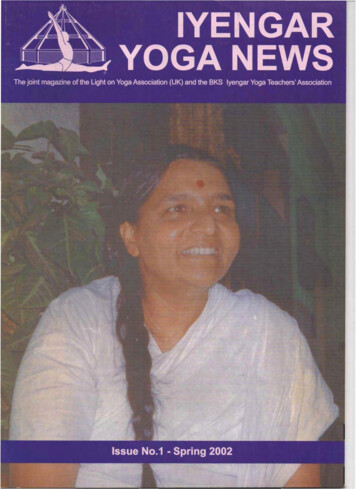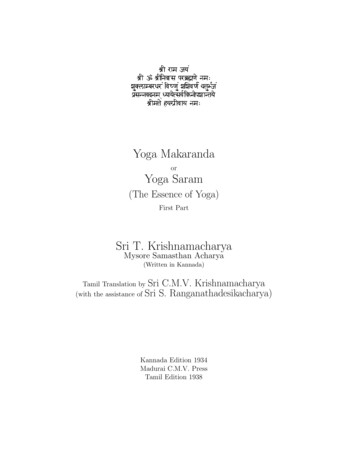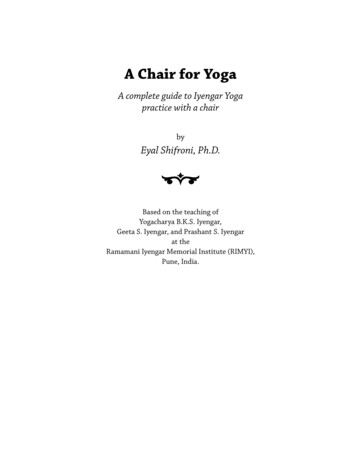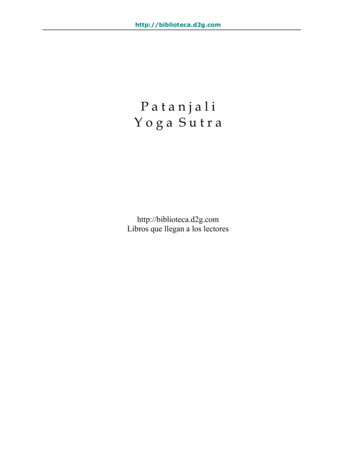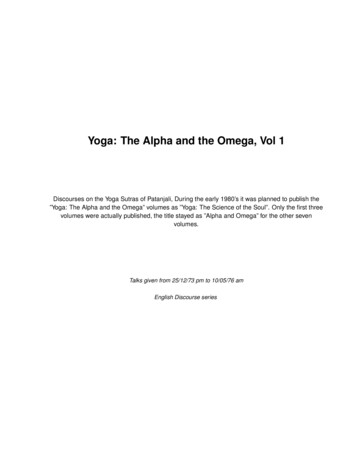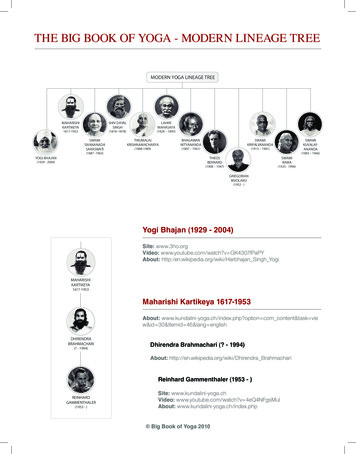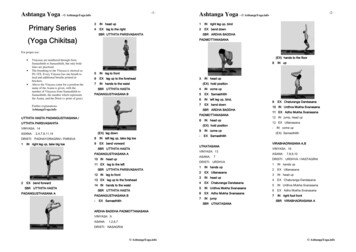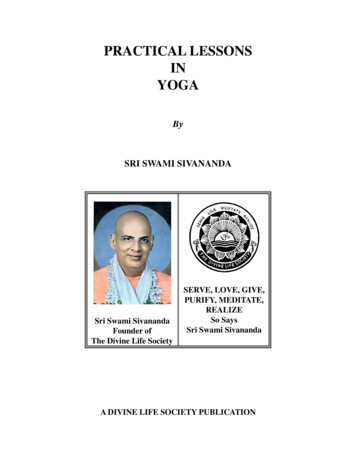
Transcription
PRACTICAL LESSONSINYOGABySRI SWAMI SIVANANDASri Swami SivanandaFounder ofThe Divine Life SocietySERVE, LOVE, GIVE,PURIFY, MEDITATE,REALIZESo SaysSri Swami SivanandaA DIVINE LIFE SOCIETY PUBLICATION
Eighth Edition: 1997(Copies 6,000)World Wide Web (WWW) Edition: 2001WWW site: http://www.SivanandaDlshq.org/This WWW reprint is for free distribution The Divine Life Trust SocietyISBN 81-7052-010-XPublished ByTHE DIVINE LIFE SOCIETYP.O. SHIVANANDANAGAR—249 192Distt. Tehri-Garhwal, Uttaranchal,Himalayas, India.
TOSTUDENTS OF YOGAINTHE EAST AND THE WEST
PUBLISHERS’ NOTEHis Holiness Sri Swami Sivananda Saraswati is, as it were, an ornament of not only theglorious Himalayas and India but of the entire world. From the cool heights of his HimalayanAshram, “Ananda Kutir,” the great Yogi stood as a mighty dynamo radiating Divine Love, Joy andPeace to millions upon millions of bleeding hearts all over the world, a Yogi, who shines as abrilliant pole-star in the spiritual firmament of the universe, guiding the tired and restless travellertowards the haven of Peace, Bliss and Knowledge.As a great saint and philosopher, his spotless purity, saintliness of life, magnetic andvoluminous writings were unparalleled in record; he was not only an eminent and popular author ofHindu religious and philosophical subjects, but is an authority on those subjects. He was not only aman of letters and vast erudition, but also one who had in a full measure realised the incalculablebenefits of Yogic practices in the course of a strenuous struggle of over fifteen years of intensedispassion and rigorous austerities in the holy regions of the Himalayas. Moreover, his pricelesswritings through the medium of some of the well-known and influential newspapers, magazinesand journals not only in India but also abroad and in America coupled with his own unique andpowerful personality and realisation have won for him an enviable place of honour in everyspiritually, religiously and philosophically inclined home in India. In fact, if the political India ofthe present day can be proud of at least one Gandhi, the spiritual India can be reasonably proud of atleast one Sivananda!The object with which this book is published is twofold. Year in and year out large numbersof Europeans and Americans, men and women, came out to India to learn Yoga under an Adept andpractice the same in India itself. In the course of their endless wanderings and searches for suchAdepts in Yoga, these people had no other alternative but to resort to the Himalayan Ashram ofSwami Sivananda. But unfortunately owing to several causes these travellers could not remain longin this country. They went back home learning something here and something there, in bits, butnothing from one Yogi only, which alone could be said to be of some solid and practical utility tothem.The Westerners, interested in Yogic practices, had naturally to take resort to books andother literature on the subject, which were either unintelligible to them or, as was more often thannot, had been written by persons whose aim in writing books was, in ninety-nine cases out of everyhundred, to show off their learning rather than to teach Yoga and make the subject intelligible andinteresting to the public. This is the difference between books written by most writers and those bySwami Sivananda. Moreover, unlike several others, Swami Sivananda Saraswati was a practicalYogi, who fully realised the fruits of Yoga and was therefore best suited to write books on thesubject from his own practical experience. The present book has been specially designed by theauthor keeping in mind the needs of the students of Yoga in Europe and America, who need apractical but non-technical presentation of the subject in a language which is accessible to thebeginner in the path. We hope the book will amply serve this most sacred purpose in view.iv
May the unfailing blessings of Swami Sivananda pour forth in profusion over the heads ofall the readers in the West and East, nay, North and South, and lead them on to Satchidananda whichevery one is seeking at heart!THE DIVINE LIFE SOCIETYPREFACEThis book entitled “Practical Lessons in Yoga” consists of twelve easy and interestingLessons. The First Lesson deals with Yoga and Its Objects. The Second Lesson treats of YogaSadhana or the practice of Yoga and contains a clear and lucid description of the four importantpaths viz., Karma Yoga, Bhakti Yoga, Raja Yoga and Jnana Yoga. One can easily choose forhimself a path according to his particular taste, temperament and capacity by a close study of thisLesson. I firmly hold that no one wishing to become a perfect Yogi can realise his wish, if he doesnot begin his Yogic practices with Karma Yoga or doing actions for actions’ sake, without the ideaof agency and without expectation of the fruits of his actions. I have also made passing references tothe various other forms of Yoga such as Hatha Yoga, Mantra Yoga and Kundalini Yoga.In the Third Lesson on Yogic Discipline I have clearly and expressly stated that the practiceof Yoga is rooted in the cultivation of virtues and the eradication of negative qualities, and have alsostated in detail what virtues should of necessity be cultivated and what vices are to be eradicated,and through what means.Yogic Diet forms the subject-matter of the Fourth Lesson. It should be distinctly borne inmind that mind is made up of the fine particles of food that we take, and we are what we eat. If thestudent of Yoga who is a neophyte desires to lay a firm, sure and sound foundation in his practices,he should take care to eat only such foods that are conducive to his spiritual advancement andprogress, and avoid all others. A list of the various articles of diet, prescribed and prohibited, is alsogiven.In the Fifth Lesson I have taken all care to collect the various stumbling blocks in the way ofthe aspirant and the various means of overcoming them. I strongly advise the student to read andre-read this Lesson a number of times in order that he may be cautious in moments of temptation.Then in the Sixth Lesson I have dealt with Yogasanas or Yogic postures. It is very necessaryfor the would-be Yogi to maintain a sound and vigorous body and mind to achieve success in hisundertaking, and in order that he might achieve this end, a number of simple and easy exercises,physical and consequently mental, have been prescribed. These exercises were practiced by Yoginsand Rishis of yore and are still being practiced in India and other countries with astonishing results.The Seventh Lesson treats of Pranayama or regulation of breath. Simple and practicalexercises have been prescribed for the regulation and control of breath. which will ultimately resultin the control of the mind. These exercises in breath-control are not merely for enhancing thesoundness and control of the mind, but they also play a vital part in ensuring a sound body. Thestudent of Pranayama who attains perfection in it will have various psychic powers.v
Regulation of breath and control of mind lead to concentration. So concentration is the topicof the next lesson. I have dealt at length with the nature of the mind and the methods through whichit can he controlled. Some practical exercises are given to attain success in concentration.The Ninth Lesson deals with Meditation because the fruit of concentration is meditation. Anumber of easy and interesting exercises have been described. The fruit of meditation is Samadhiand this forms the subject-matter of the next lesson. Samadhi is superconscious state, wherein theYogi gets superintuitional or supersensual knowledge and supersensual bliss. In Samadhi the Yogicommunes with the Lord and enjoys Absolute Independence. He has reached the Goal now.In the Eleventh Lesson I have dealt with the Serpentine Power or the mighty pristine Forceunderlying all organic and inorganic matter. This Force is in a dormant state and is sleeping asleep-trance in almost all persons in the basal Muladhara Chakra. When this sleeping Force isroused to action, it pierces through the various centres of spiritual energy in the human body andreaches the crown of the head or the Sahasrara Chakra where She is united with Her Consort, LordSiva. That Yogi who has taken the sleeping Kundalini to the Sahasrara Chakra and united Her withLord Siva alone has attained the Goal, not others. The process by which this sleeping Power can beroused to action and taken to the top of the head has also been described with beautiful illustrations.The Yogi who has succeeded in achieving this union becomes the Lord of all powers andknowledge.In the last Lesson on Spiritual Vibrations and Aura I have stated what vibration and auramean and various means of producing vibrations of love, joy, peace, mercy sympathy and purity,and developing the spiritual aura. I have also stated in brief that the human aura has various coloursaccording to the growth and development of a person physically, mentally, morally and spiritually,and that each colour has got its own significance and meaning. The would-be Yogi should dispel allother colours and develop the particular spiritual aura, the colour of which is yellow.At the end of the book an Appendix has been added and a Glossary of Sanskrit terms given.In Appendix I a daily routine for aspirants has been chalked out, one for the beginner, another forthe intermediate student and a third for the advanced Yogi. I believe that if a similar routine chalkedout according to one’s own necessity and convenience is followed regularly and systematically,nothing would stand in the way of the aspiring Yogi to achieve success in Yoga. Moreover, heshould also maintain a Spiritual Diary similar to the one given in the Appendix realising theimportance and benefits of such a discipline. In Appendix II an interesting article on Yoga andScience has also been added in the belief that it would be read with considerable interest.I appeal to the students of Yoga in the East and the West to start doing some spiritual andYogic practice in right earnest after digesting and assimilating the truths and ideals inculcatedherein and I hope they would be immensely benefited by this book.Sivanandavi
THE UNIVERSAL PRAYERThou art, O Lord! the Creator of this universe. Thou art the Protector of this world. Thou artin the grass and the rose. Thou art in the sun and the stars. Salutations unto Thee, O Destroyer of thecycle of births and deaths! Salutations unto Thee, O Bestower of Bliss and immortality!O sweet Lord! May I be free from the bonds of Death. May I never again forget myimmortal nature. May I be able to look upon all with equal vision. May I attain the Supreme Seat ofBrahman. May I be free from impurity and sin. May I know my real essential nature.Adorations to the Supreme Being who dwells in the hearts of all beings, who is in the fireand water who is in the plants, herbs and trees, who is in the stones, bricks and iron-bars and whohas pervaded the whole universe.I bow to Thee, O Secret of secrets! I bow to Thee, O Indweller of our hearts! I bow to Thee,O Silent Witness of all activities of all minds! I bow to Thee, O Inner Ruler of all beings! I bow toThee, O Thread-Soul who connects all beings, who pervades and permeates and interpenetrates allthings of this universe!Salutations to Thee, the Supreme Lord. Thou art without beginning and end. Thou art theflower; Thou art the bee; Thou art woman; Thou art man; Thou art the sea; Thou art the waves;Thou art the old man tottering with a stick; Thou art the saint; and Thou art the rogue.Thou art Light Divine. Thou art Light of Knowledge. Thou art the Dispeller of darkness.Thou art the Supreme Guru. Thou art beyond the reach of mind and speech. Thou art beyond anykind of limitation. Thou art the Oversoul. Thou art the Self of this universe.Thou art Self-luminous. Thou art without parts, without actions, without limbs, without anytaint of fault, without birth and death. Thou art our Father, Mother, Brother, Friend, Guru, Relativeand sole Refuge. Thou art the embodiment of Peace, Bliss, Knowledge, Power, Strength andBeauty.O All-merciful Lord! Through Thy Grace, may I realise Truth. May I always entertainsublime thoughts. May I realise myself as the Light Divine. May I behold the one sweet immortalSelf in all beings. May I realise Brahman with pure understanding.May that Light of lights ever guide me. May He cleanse my mind of all impurities. May Heinspire me. May He bestow on me Power, Courage and Strength. May He remove the veil in themind. May He remove all obstacles in the Spiritual Path. May He make my life happy and fruitful. Ibow to Thee O Lord of lords, O God of gods, O Deva of devas, O Brahman of the Upanishads, theSupport for Maya and Isvara, the Supreme Bridge to Immortality!Om Peace! Peace! Peace!vii
INTRODUCTIONThe Religion of the Vedanta and Yoga stands forth as a brilliant guiding star to the studentof Yoga Philosophy and Occultism, inviting him to the mysterious unknown world, which hewould gladly explore, and encouraging him to march onward until he reaches a stage, when allpowers dear to every human heart lie at his command, and all earthly attractions cease to influencehim any more. It is a truism that it is in the nature of every human being to strive for happiness, butthe happiness he gains by his actions, he finds to his utter dissatisfaction and sorrow, is only of alimited duration. The enjoyments of the senses are transient, and the senses themselves are worn outby excessive enjoyment. Further sin generally accompanies these enjoyments and makes himunhappy beyond comparison. Even if the pleasures of the world are enjoyed as much as their naturewould permit, even if they are as intense, as various, as uninterrupted as possible, yet old age in allits hideous shape threatens him with death and destruction. It should be remembered that theenjoyments of heaven itself are not in reality more enviable than these
student of Yoga who is a neophyte desires to lay a firm, sure and sound foundation in his practices, he should take care to eat only such foods that are conducive to his spiritual advancement and progress, and avoid all others. A list of the various articles of diet, prescribed and prohibited, is also given. In the Fifth Lesson I have taken all care to collect the various stumbling blocks in .
